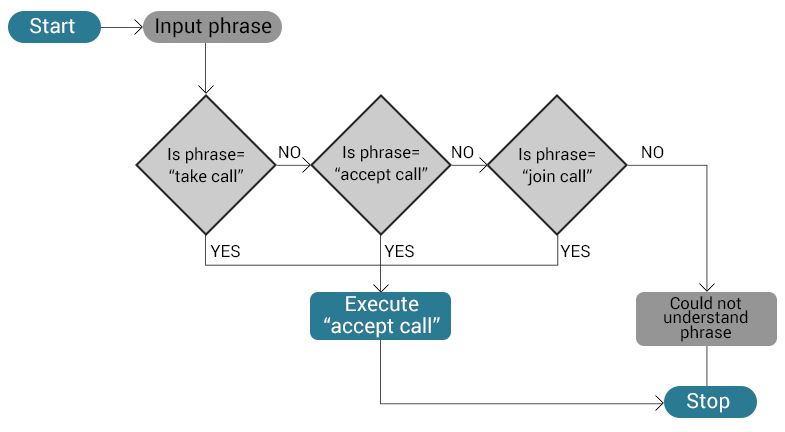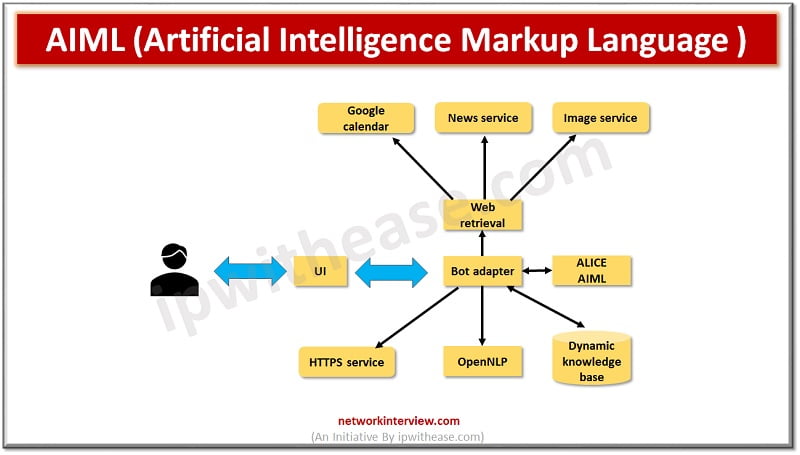Artificial Intelligence Markup Language (AIML)
AIML stands for Artificial Intelligence Markup Language. AIML is an XML-based markup language that helps to create chatbots, virtual assistants, and other conversational interfaces.
AIML defines the knowledge and behavior of the AI system, allowing it to understand and respond to user input in a more natural and human-like way.
It uses a combination of pattern-matching and template-based responses to create dynamic and engaging conversations with users.
It is a popular choice for creating chatbots and virtual assistants because it is easy to learn and customize and can integrate with a wide range of messaging platforms and other applications.
What are the Fundamentals of AIML?
Fundamentals of Artificial Intelligence Markup Language (AIML):

Categories
Categories are the fundamental units of AIML conversations. Each category consists of a pattern and a template representing the user's input and the chatbot's response, respectively.
The AIML interpreter matches the user's input with the patterns in the categories to determine the appropriate response.
You can add optional attributes to provide additional information about the pattern or the Template.
Wildcards and Sets
AIML supports wildcards, which match any word or phrase in a pattern. Wildcards are represented by an asterisk (*) or underscore (_).
Sets define a group of related words that the chatbot can match against. Wildcards and sets allow for more flexible and sophisticated pattern matching.
Substitutions
AIML provides various substitutions, which replace words or phrases in a template with other words or phrases.
Substitutions can be used for personalization, to create variations in the chatbot's responses, or to provide additional information.
SRAIX
Search, Retrieve, and Answer Input extension (SRAIX) is a mechanism in AIML that allows chatbots to retrieve information from external sources, such as APIs or databases.
SRAIX can be used to provide more complex and dynamic responses to users.
Importance of AIML

AIML has various applications across various industries, including healthcare, finance, retail, and transportation.
In healthcare, AIML is being used to diagnose diseases, develop treatment plans, and analyze medical images. In finance, AIML is used for fraud detection, risk management, and trading.
In retail, AIML is used for personalized marketing, inventory management, and customer service. In transportation, AIML is used for autonomous vehicles, traffic management, and logistics.
The benefits of AIML are significant, including increased efficiency, improved accuracy, and reduced costs.
There are also challenges and limitations to AIML, such as bias in data, lack of transparency, and ethical concerns. It is essential to address these challenges to ensure that AIML is used responsibly and ethically.
There are many case studies and examples of AIML in real-world scenarios, such as Google's AlphaGo, which beat the world champion in the game of Go, and IBM's Watson, which won Jeopardy! against human champions.
Who is using AIML?
Various industries and sectors, including healthcare, finance, retail, transportation, and more, are using AIML.
For example, in healthcare, IBM's Watson is being used to help doctors diagnose and treat cancer patients. JPMorgan Chase uses AIML to detect fraud and improve customer service in finance.
In retail, Amazon uses AIML to personalize customer recommendations and improve supply chain management.
There are also emerging areas of AIML research and development, such as explainable AI, which aims to make AI more transparent and understandable, and ethical AI, which focuses on responsible and ethical use.
How Does AIML Work?
AIML works by using machine learning algorithms to analyze data and identify patterns.
Machines can learn differently, including supervised, unsupervised, and reinforcement learning.
In supervised learning, the machine learning model is trained using data that has already been labeled.
In contrast, unsupervised learning involves training a model on unlabeled data. Reinforcement learning involves training a model to make decisions based on rewards and punishments.
After training a machine learning model, it is tested on new data to evaluate its performance.
Once the model is deemed accurate, it can be implemented in various settings, such as chatbots, virtual assistants, and autonomous vehicles.
What are the Important AIML tags?
.jpg)
The most important Artificial Intelligence Markup Language tags:
- Category Tag: The Category tag is the most fundamental in AIML. It defines the conversation category and consists of a pattern and a template.
The pattern is the chatbot's input, and the template is the chatbot's response.
- Pattern Tag: The Pattern tag is used to define the input that the chatbot will respond to. It can contain one or more pattern elements, including wildcards and variables.
Wildcards are used to match any word or phrase. In contrast, variables are used to capture and store information from the user's input.
- Template Tag: The Template tag is used to define the response that the chatbot will give. It can contain one or more template elements, including text, HTML, and AIML tags.
Template elements help format the chatbot's response by adding line breaks or links.
- Star Tag: The Star tag captures and stores information from the user's input. It can be used in pattern and template tags and is denoted by an asterisk (*).
The Star tag can capture single words or entire phrases.
- Srai Tag: The Srai tag redirects the chatbot's response to another category. It can be used to create a conversation flow and handle complex conversations.
The Srai tag takes the name of another category as its input and returns the response of that category.
- Set Tag; The Set tag is used to assign a value to a variable. It can store information from the user's input and use it later in the conversation.
The Set tag takes the name of a variable and its value as its input.
- Get Tag: The Get tag is used to retrieve the value of a variable. It helps recall and use information from previous conversations in the current conversation.
The Get tag takes the name of a variable as its input.
What's Next for AIML
AIML is growing like a rocket ship, and it has the ability to change all kinds of industries.
But let's not forget about the big problem. There are some problems to solve, such as problems with the data and ethical issues.
We must face these problems head-on and ensure that AIML is used responsibly and decently.
AIML is always changing quickly, so keeping up with the latest trends and changes is important. So everyone, fasten your seatbelts and get ready for the ride!
Frequently Asked Questions (FAQs)
What is AIML, and how is it related to AI chatbots?
AIML, or Artificial Intelligence Markup Language, is an XML-based language used to create rules and patterns for AI chatbots, enabling them to understand and respond to user queries based on these predefined rules.
How do developers create chatbot conversations using AIML?
Developers use AIML to define patterns, possible user inputs, templates, or chatbot responses.
By creating rules with matching patterns and templates, developers can design chatbot conversations that cover a wide range of user interactions.
Can AIML chatbots handle complex conversations?
AIML chatbots have limitations, as they rely on predefined rules and lack conversational AI systems' advanced natural language processing capabilities.
They may struggle with complex conversations, context, and ambiguity in user inputs.
What tools or platforms support AIML development?
Popular platforms for AIML development include Pandorabots, Program O, and Chatscript. These platforms provide tools and resources to help developers create, test, and deploy AIML chatbots.
What are some limitations of AIML compared to modern AI chatbot technologies?
AIML-based chatbots have limitations in understanding context, handling ambiguity, and adapting to new inputs, as they rely on predefined rules.
Modern AI chatbot technologies, like Conversational AI, leverage natural language processing and machine learning for more advanced, context-aware, and adaptive interactions.


